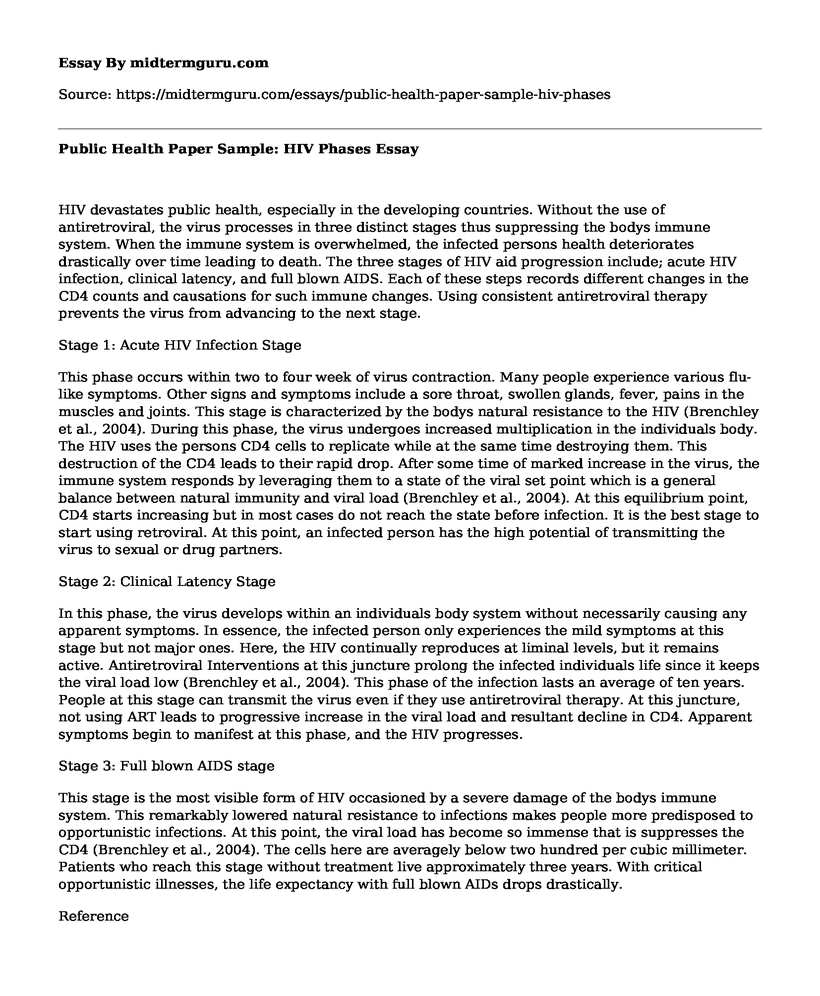HIV devastates public health, especially in the developing countries. Without the use of antiretroviral, the virus processes in three distinct stages thus suppressing the bodys immune system. When the immune system is overwhelmed, the infected persons health deteriorates drastically over time leading to death. The three stages of HIV aid progression include; acute HIV infection, clinical latency, and full blown AIDS. Each of these steps records different changes in the CD4 counts and causations for such immune changes. Using consistent antiretroviral therapy prevents the virus from advancing to the next stage.
Stage 1: Acute HIV Infection Stage
This phase occurs within two to four week of virus contraction. Many people experience various flu-like symptoms. Other signs and symptoms include a sore throat, swollen glands, fever, pains in the muscles and joints. This stage is characterized by the bodys natural resistance to the HIV (Brenchley et al., 2004). During this phase, the virus undergoes increased multiplication in the individuals body. The HIV uses the persons CD4 cells to replicate while at the same time destroying them. This destruction of the CD4 leads to their rapid drop. After some time of marked increase in the virus, the immune system responds by leveraging them to a state of the viral set point which is a general balance between natural immunity and viral load (Brenchley et al., 2004). At this equilibrium point, CD4 starts increasing but in most cases do not reach the state before infection. It is the best stage to start using retroviral. At this point, an infected person has the high potential of transmitting the virus to sexual or drug partners.
Stage 2: Clinical Latency Stage
In this phase, the virus develops within an individuals body system without necessarily causing any apparent symptoms. In essence, the infected person only experiences the mild symptoms at this stage but not major ones. Here, the HIV continually reproduces at liminal levels, but it remains active. Antiretroviral Interventions at this juncture prolong the infected individuals life since it keeps the viral load low (Brenchley et al., 2004). This phase of the infection lasts an average of ten years. People at this stage can transmit the virus even if they use antiretroviral therapy. At this juncture, not using ART leads to progressive increase in the viral load and resultant decline in CD4. Apparent symptoms begin to manifest at this phase, and the HIV progresses.
Stage 3: Full blown AIDS stage
This stage is the most visible form of HIV occasioned by a severe damage of the bodys immune system. This remarkably lowered natural resistance to infections makes people more predisposed to opportunistic infections. At this point, the viral load has become so immense that is suppresses the CD4 (Brenchley et al., 2004). The cells here are averagely below two hundred per cubic millimeter. Patients who reach this stage without treatment live approximately three years. With critical opportunistic illnesses, the life expectancy with full blown AIDs drops drastically.
Reference
Brenchley, J. M., Schacker, T. W., Ruff, L. E., Price, D. A., Taylor, J. H., Beilman, G. J., ... & Douek, D. C. (2004). CD4+ T cell depletion during all stages of HIV disease occurs predominantly in the gastrointestinal tract. Journal of Experimental Medicine, 200(6), 749-759.
Cite this page
Public Health Paper Sample: HIV Phases. (2021, May 28). Retrieved from https://midtermguru.com/essays/public-health-paper-sample-hiv-phases
If you are the original author of this essay and no longer wish to have it published on the midtermguru.com website, please click below to request its removal:
- Pathophysiology and Epidemiology: Childhood Asthma
- Methodologies of Successful Euthanasia for the Elderly - Paper Example
- Essay on the Issue of Abortion
- Paper Example on Peplau's Theory of Interpersonal Relations
- Paper Example on HIV/AIDS: In Search of a Cure
- Asthma: A Global Health Threat Affecting 300 Million People - Research Paper
- Disability Service Providers: A History of Successful Support Services - Essay Sample







